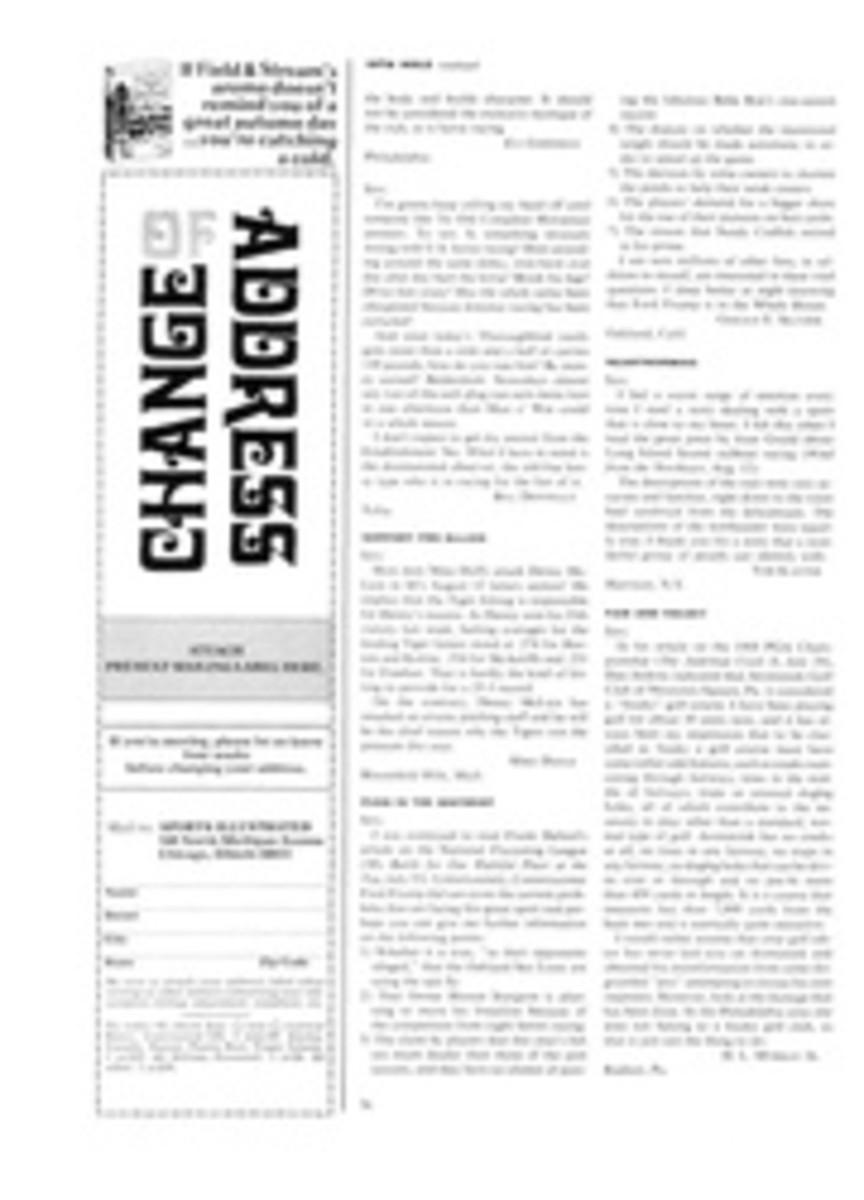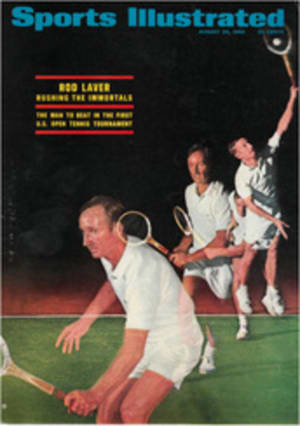
SORE SPOTS IN A BIG-ARM YEAR
Every time Denny McLain chug-a-lugs another dozen Pepsis and wins another game, Jim Bouton of the Seattle Angels drinks a glass of Knox Gelatine and walks to the bullpen to experiment with his knuckleball. Every time Bob Gibson mercilessly strikes out some defenseless hitter, Jim Palmer of the Elmira Pioneers winces and thinks, "There I was just two years ago, getting ready to pitch in the World Series." And every time Don Drysdale or Juan Marichal shuts out a team of .193 hitters, faceless kids like Tom Fletcher and Dennis Musgraves try a little harder to fool the hitters in Denver and Memphis with their slow, breaking pitches.
This year, while the McLains and Gibsons and Drysdales and Marichals dominate the pitching revolution in the major leagues, the Boutons and Palmers and Fletchers and Musgraves linger obscurely in the minor leagues—all trying to recover from sore arms. They are only a handful of the sore-armed victims of present-day baseball.
Wally Bunker, 23, Don Sutton, 23, and Gary Nolan, 20, developed bad arms after instant success with the Orioles, Dodgers and Reds. They still are pitching in the major leagues, but the most any of them has been able to achieve is five victories. Most of baseball's other sore-armed pitchers are not as fortunate as these three. For every strong-armed Ferguson Jenkins or Luis Tiant, who take their regular pitching rotations in Chicago and Cleveland, there are five Fred Newmans and Tom Kelleys and Chuck Estradas and Art Mahaffeys and Jerry Walkers, who savored success for a short time and then silently faded into the obscurity of El Paso or Waterbury, their arms stitched up or cast in a sling.
The guilty party in most sore-arm cases is baseball's front office—the general managers and club presidents who meditate over the best 86 Proof and seem more obsessed with the count of the turnstiles than the physical capabilities of their athletes. What has happened is this: in its haste to create instant McLains or Gibsons or Tiants, pitchers who win about every four days and attract large crowds at the same time, the baseball hierarchy has subjected tender, young pitching arms to intolerable pressures. Management seems to operate on the theory that if it produces one good young pitcher and six sore-armed kids every year, then all is well in the conference room. Perhaps it is.
So the scouts sign gangs of promising young throwers, and the front office assigns them to Williamsport or Aberdeen or Sioux Falls. It does not matter that these teams probably do not have pitching instructors or adequate medical and training-room facilities. There are 10 pitchers on the minor league roster; the big club hopes maybe one of them will make it to the majors.
One pitcher usually does—for a while, anyway, until his arm becomes sore. In most cases the big-league team has simply overworked an arm that was not ready for major league ball. Consider the records of four young pitchers.
1) Wally Bunker pitched 99 innings and had a 10-1 record for Stockton, Calif. in 1963. The next year he pitched 214 innings and won 19 games for the Orioles. In 1965 he began to complain of a sore arm. Three years later he opened the 1968 season at Rochester.
2) Don Sutton pitched 249 innings in his first two seasons of pro ball in the Dodger organization. In 1966 he was the No. 4 starter for the Dodgers and pitched 226 innings—winning 12 games. He did not pitch in the World Series that fall, however. His arm was sore.
3) Gary Nolan pitched 104 innings for Sioux Falls in 1966, his first season as a pro. Last year he hurled 227 innings for the Cincinnati Reds and won 14 games. This year, complaining of a sore and tired arm, he has pitched 81 innings and won five games.
4) Jim Palmer pitched 221 innings in his first two seasons of pro ball. In 1966 he worked 208 innings for the Orioles and beat Sandy Koufax (who pitched only 205 innings in his first three years as a Dodger) in the World Series. Last year, his arm very sore, he threw for only 83 innings. Now he is in Elmira and thinks of becoming a first baseman.
These four pitchers managed to have at least one outstanding year in the major leagues. Many others have not been that lucky. Six years ago the Tigers gave a lefthander, Tom Fletcher, more than $50,000 to drop out of the University of Illinois. Fletcher pitched at Knoxville for a few months, then in September he was brought up to Detroit. Within two weeks he was in Henry Ford Hospital—his left side paralyzed. "I had what they call thrombophlebitis, a disease of the veins," Fletcher said the other day between starts for the Denver Bears of the Pacific Coast League. "I couldn't play in 1963 because I had to wear an elastic case that served as a blood pump for the veins in my arm. I pumped it 300 times a day to get the blood circulating."
Fletcher returned to baseball in 1964, but his arm was sorrowfully weak. Last month, still unable to throw hard, he was given his release. He negotiated a contract with Denver, a Minnesota farm team. "The expansion draft is in the fall," he said, "and if I don't get picked up—or if the Twins don't invite me to spring training—I'll go home to Danville, Ill. and finish up my schooling."
Four years ago the New York Mets gave fastballer Dennis Musgraves more than $100,000—still the largest bonus in their history—to drop out of the University of Missouri. Unfortunately, Musgraves injured his elbow. Fortunately, he stayed with baseball, trying to work out his miseries as a relief specialist for the Memphis Blues of the Texas League.
"It happened after I had pitched for the Mets in Chicago in July of 1965," Musgraves said the other day. "I had started against the Cubs and was losing 1-0 when they took me out for a pinch hitter in the seventh inning. The next day my right elbow was so swollen I could hardly lift it. I had an exploratory operation that fall, and then in August of 1966—a year after it all happened—they did a do-or-die operation and took a bone out of my elbow."
His fastball gone for good, Musgraves now throws sharp-breaking curveballs and off-speed pitches that he hopes will be hit into the ground—and not over the fences. "I know how it all happened," Musgraves said. "I'm sure the same thing happens to every kid who comes down with a bad arm. You get a chance to pitch in the majors, and maybe you're not really ready for it. You go up there and try to throw everything a little too hard. You try to throw a faster fastball, a sharper curve. You overextend your pitching limits, and when you do that you throw yourself out of whack someplace. As a result you put too much pressure on your arm. And at that point of your development, your arm can't take it."
There may be a solution for all this. Jerry Walker, considered phenomenal as a 20-year-old in 1959 when he won the All-Star Game for the American League, and now the 29-year-old manager of the Oneonta (N.Y.) Yankees of the New York-Penn League, came down with a sore arm after his early pitching success. Today, as he looks back, he thinks about what happened. "All these kids—the kids who came up with me, the kids like Nolan and Bunker and Sutton today—all hurt their arms early in their careers. Well, pitchers in the minor leagues must face only one or two real good hitters in a lineup. Then they're called up to the majors. They pitch in a rotation against nine good hitters—and they aren't ready to handle the load. They press too much, and soon their arms are hanging. My idea is to work them hard in the minors and let up on them their first years in the majors."
The problem of sore arms is not confined strictly to young kids. Throughout the minor leagues veterans such as Dick Radatz and Jim O'Toole and Jim Bouton, all of whom were making $30,000 or more two or three years ago, are trying to overcome various arm injuries and survive through a few years of expansion baseball.
Bouton, in fact, now is owned by the new Seattle team of the American League, but he is pitching today for the old Pacific Coast League Seattle club, known formerly as the Rainiers but recently as the Angels when they became an affiliate of Anaheim. The Yankees discarded Bouton a few months ago when it became obvious that he would never recapture the fastball that helped him win 21 games in 1963 and then 18 more in 1964. "My pitching motion those two years was a symphony," Bouton said the other day, "and then in 1965 it started to become violent.
"Three weeks ago I decided to become strictly a knuckleballer," Bouton said. "Look at Hoyt Wilhelm. What's he, 45? I drink the Knox Gelatine because it makes my fingernails strong, and I cut the nails of my right fingers real square—so the ball will not rock during my delivery. The knuckler is in the embryo stage right now. But I'm going to ride it back to the majors."
And Dennis Musgraves is trying to ride back to the big leagues with a curve. And Gary Nolan is attempting to stay in the majors without his old fastball. This happens when young arms turn old, because old heads in front offices are willing to waste a few arms for immediate, seasonal success.
PHOTO
Fire bailer Dennis Musgraves, signed by the Mets for $100,000, works painfully now, developing his curve in Memphis.

